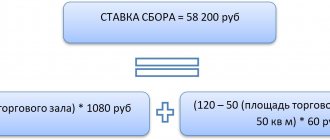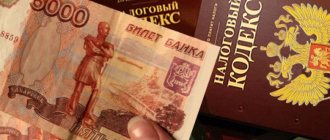The very concept of KBK implies a simple set of numbers that mean absolutely nothing to an ignorant person. The system was developed by the state to simplify settlements and payments to the state treasury.
Incorrectly entering any details into payment documents, incorrectly filling out declarations and receipts, or inaccuracy in one figure can lead to serious problems. Let's look below at how penalties are calculated and how to correctly fill out the VAT penalty in the KBK, and we will provide a sample of filling out payment orders .
BCC for VAT penalties
Like any other type of tax, penalties have their own article and classification code. And, accordingly, it is divided into different groups. When paying a VAT penalty, you must indicate the correct details in the column; they consist of a set of the following numbers:
- BCC for penalties on Russian goods - 182 1 03 01000 01 2100 110.
- For goods from the customs union - 182 1 04 01000 01 2100 110.
- Goods from other countries - 153 1 0400 110.
Penalties, like any other tax, are a collection of money from you and me. Therefore, in order to limit yourself from losing money, try to fill out declarations and any payment orders correctly and pay taxes on time.
Which code to use (table)
In accordance with the norms of tax legislation, a fine is subject to accrual and transfer by those taxpayers if there is a delay in mandatory payments.
At the same time, companies reserve the right to independently calculate penalties or pay based on requirements from the territorial representative office of the tax authority.
A fine from the tax inspectorate refers to sanctions for an established offense on the basis of Article 114 of the Tax Code of the Russian Federation, one of which is considered to be non-payment of tax in full or in part (according to Article 122 of the Tax Code of the Russian Federation).
Below are the BCCs for the purpose of paying accrued interest and fines for value added tax this year:
| Type of taxation | Penalty for value added tax | Value Added Tax (VAT) Penalties |
| VAT on products (services provided or work performed) that are subject to sale directly in Russia | 182 1 0300 110 | 182 1 0300 110 |
| Value added tax on products imported into Russia from the territory of Belarus and the Republic of Kazakhstan | 182 1 0400 110 | 182 1 0400 110 |
| Value added tax on products and goods that are subject to import into Russia (the payment administrator in this case is the Federal Customs Service of Russia) | 153 1 0400 110 | 153 1 0400 110 |
It should be noted that if an error is made when entering the BCC into the payment slip, tax legislation provides the opportunity to return the amounts paid or to make a so-called offset with other taxation in the existing arrears on them.
In addition, Article 45 of the Tax Code of the Russian Federation allows for the possibility of clarifying the payment if errors are made in the KBK, but subject to the transfer of funds to the Federal Treasury.
The concept of penalties and reasons for their formation
The very concept of a penalty is a certain type of fine for untimely fulfillment of obligations established by law. From Latin and translated as “punishment.” This is the amount of a certain tax that the taxpayer is deprived of. A penalty is established if a number of violations are identified:
- Missing a payment during a certain period.
- Errors in the details being filled out.
- Ensuring the fulfillment of property obligations.
The penalty interest itself is calculated at a certain rate, and can also be assigned for each overdue day. Specifically, the VAT penalty implies compensation in monetary terms.
In any business activity, errors arise that can be made by the organization’s accountant, or violations in the course of the enterprise’s activities.
Late payment of declarations, receipts, and advance payments is already a reason for charging late fees and penalties.
For tax agents
Tax agents for VAT are, in accordance with Art. 161 Tax Code of the Russian Federation:
- tenants of property from government agencies and local governments;
- purchasers of goods, work and services from foreign organizations operating in the Russian market, which themselves are not registered as taxpayers in the Russian Federation;
- buyers of state property, with the exception of individual entrepreneurs;
- bodies, companies and individual entrepreneurs authorized to sell confiscated property, etc.;
- from 01.10.2011 - buyers of property and (or) property rights of debtors declared bankrupt (with the exception of individuals who do not have the status of individual entrepreneurs);
- registered as taxpayers (organizations and individual entrepreneurs) carrying out business activities using agency agreements, commission agreements or agency agreements, and making settlements under them with foreign persons who are not registered with the tax authorities as taxpayers.
The tax agent indicates its status in field 101, which is designated by the code “02”.
| Status | BCF value |
| Tax agent | 182 1 0300 110 |
Self-calculation of penalties
Perhaps you are faced with the problem of calculating and paying penalties, and you need to correctly calculate the amount. Let's use the following scheme:
- We determine the amount of the penalty. This is an indicator of the amount owed.
- We determine the days overdue from debt repayment.
- We look at the Central Bank refinancing rate. This indicator is indicated on the Central Bank website.
- We calculate using the formula - P = Week * St. Ref. / 300 - Pr ,
Where:
- P – the amount to be paid for the penalty itself;
- Art. ref. — refinancing rate in effect at the time the penalty is issued;
- Pr - number of overdue days.
You can also use a calculator to calculate penalties or obtain data on the accrual of penalties from regulatory authorities.
When independently calculating penalties, the taxpayer must take into account the next day, that is, the day of seizure.
The correct calculation of penalties can be considered using an example.
Let's say a certain organization Vympel LLC filed a tax return. It indicated the amount that was not paid to the tax authority on time. As a result, a penalty was charged:
| VAT amount | VAT paid | Arrears | Payment deadline | Number of days | Calculation | Sum |
| 840,200 | 500,260 | 840,200— 500,260 = 339, | .01.2016 | 12 | 339, rub. * 11% / 300 * 12 days | 1,495 |
| 880,730 | 319,400 | 880,730— 319,400 = 481,33 | .02.2016 | 14 | 481.33 * 11% / 300 * 14 days | 2,47 |
| 720,610 | 649,80 | 720,61— 649,8 = ,81 | .03.2016 | 19 | .81 rub. * 11% / 300 * 19 days | 0,49 |
As a result, the amount of the penalty amounted to 4.461 rubles; we sum up all the columns (1.495+2.476+0.49)
The day the penalty is paid is considered the day the document is processed and funds are credited to the account of the organization that assigned these penalties.
The tax authority will collect penalties corresponding to the unpaid VAT tax unconditionally. For this purpose, government services, such as the bailiff department, will be involved.
In tax inspectorates, programs for calculating penalties are set to automatic mode. To keep abreast of all calculations, you need to constantly take certificates and statements in order to pay the accrued amounts on time.
Who pays and when
According to Art. 143 of the Tax Code of the Russian Federation, taxpayers for this type of fee are legal entities and individual entrepreneurs, but it is believed that ultimately it is paid by the buyer. The fact is that value added tax is indirect. With its help, the state seeks to receive part of the premium that the manufacturer or seller sets on the price of the product at each stage of production or sales. The tax is calculated by the manufacturer and the seller, but it is included in the cost of the product; in addition, the entrepreneur deducts the input VAT already paid when purchasing goods for production. Thus, the buyer is the source of the collection, but in the legislative act - in the Tax Code - individuals are not mentioned as VAT payers; they do not calculate or transfer it.
This financial commitment is of great importance for the budget and not only in terms of revenue. The state, by introducing a value added tax, ensures the contribution of funds to the budget earlier than the final sale of products, which increases the efficiency of the obligation and its collection.
IMPORTANT!
From 01/01/2019, VAT has been increased from 18% to 20%.
Reducing penalties
Sometimes situations arise when the taxpayer is unable to pay the tax and penalties on it. Judicial practice shows that it is impossible to change or remove penalties, since this type of tax is not a tax charge. Tax authorities can write off “bad” debts, but the taxpayer will have to pay penalties in any case. It is possible to highlight which articles of offenses are exempt from liability:
- Committing a tax offense.
- Inability to pay due to bankruptcy.
VAT in 2020 - deadlines, penalties, fines
The KBK for VAT 2020 for legal entities and individual entrepreneurs is necessary to know in order to correctly fill out VAT payments and avoid penalties from the tax authorities. As before, the VAT amount must be calculated based on the results of each quarter. Payments are made evenly over the next three months. Payment is made no later than the 25th day of the month following the reporting quarter.
For example, VAT for the first quarter of 2020 must be transferred to the budget in equal shares no later than April 25, May 25 and June 25, 2020. Payments for subsequent quarters of 2020 will proceed similarly.
In turn, the VAT tax return is submitted by the 25th day of the month following the reporting quarter.
Article 75 of the Tax Code of the Russian Federation VAT contains the rule: penalties may be charged for late payment of VAT in 2020. In case of underpayment or complete non-payment of tax revealed as a result of an audit, a legal entity can be held liable in the form of fines (Article 122 of the Tax Code of the Russian Federation, Article 15.11 of the Code of Administrative Offenses of the Russian Federation). There are separate BCCs for transferring fines and penalties; they cannot be mixed with the main payment.
Let us remind you that from October 1, 2020, the rules for calculating VAT penalties have changed. These rules remain in effect in 2020.
Actions if an error is made according to the KBK
If an error is detected in a timely manner when the BCC is incorrectly reflected in the payment order, the taxpayer or agent has the right to fight to ensure that penalties are not assessed to him, so, if an error is discovered, you can ask the Federal Tax Service to clarify the payment. To do this, you need to write an application to the Federal Tax Service to clarify the payment and attach a document confirming the transfer of VAT in a timely manner, but with an error.
The Tax Code of the Russian Federation does not establish special requirements for the application; it can be written in free form, but like all documents in the application form, the following minimum requirements are imposed:
- destination
- details of the organization – name, INN/KPP, OGRN, address
- name of the document - application
- the main text describes the essence of the problem (clarification of payment due to incorrect BCC)
- payment date and incorrect BCC
- correct KBK, according to which the amount is correctly transferred
- please reflect the correct payment and no penalty
Copies of payment orders must be attached to the application to confirm this document and the request contained in it:
- copies of payment orders (with errors and correct)
- bank statement
Change 3: restoration of VAT when receiving subsidies
Taxpayers will need to restore VAT from July 1, 2020, regardless of which budget they received subsidies for reimbursement of expenses from. At the same time, the procedure for restoring and accounting for the restored tax amount remained the same. The amendments are provided for in paragraph 4 of Article 2 of the Federal Law of November 30, 2016 No. 401-FZ
Note that previously VAT was restored if the subsidy came exclusively from the federal budget. Let us illustrate the essence of the change in the table:
| Amendment | |
| Was | It became |
| Amounts of tax accepted for deduction by the taxpayer on goods (work, services), including fixed assets and intangible assets, property rights, are subject to restoration by the taxpayer in the event that the taxpayer receives subsidies from the federal budget in accordance with the legislation of the Russian Federation to reimburse costs associated with payment for purchased goods (works, services), including tax, as well as reimbursement of costs for paying tax when importing goods into the territory of the Russian Federation and other territories under its jurisdiction. | Amounts of tax accepted for deduction by the taxpayer on goods (work, services), including fixed assets and intangible assets, property rights, are subject to restoration by the taxpayer in cases where the taxpayer receives subsidies for reimbursement of costs from the budgets of the budget system of the Russian Federation in accordance with the legislation of the Russian Federation (including tax) related to payment for purchased goods (work, services), taking into account tax, as well as reimbursement of costs for paying tax when importing goods into the territory of the Russian Federation and other territories under its jurisdiction. |
That is, the point of the innovation is to introduce the obligation to restore VAT in the event of the allocation of subsidies (to cover previously incurred costs) from any budget (local, regional, federal).
The moment when the obligation to recover VAT arises is determined in paragraph 4 of paragraph. 6 clause 3 art. 170 of the Tax Code of the Russian Federation as the quarter in which the subsidy was received. Therefore, for the purpose of VAT recovery, it does not matter when the taxpayer accepted purchases (goods, works, services) for accounting and (or) paid them to the supplier (contractor, performer). VAT is restored in the quarter in which the subsidy funds are credited to the taxpayer's account.
It is worth noting that the amended wording of subparagraph 6 of paragraph 3 of Article 170 of the Tax Code of the Russian Federation still contains the words “including tax”. Consequently, if the subsidy is allocated without taking into account VAT and credited to the current account after 07/01/2017, then the taxpayer will not have the obligation to restore the VAT amounts previously accepted for deduction. In other words, from July 1, 2020, it will be possible to avoid the obligation to restore VAT only if the documents for the allocation of the subsidy state that the subsidy amount does not include VAT.
VAT tax rate - 0% in 2020
The zero tax rate has found its application in 2020. The list of goods and services to which the preferential rate applies has not changed. The procedure for documents for confirmation is specified in Article 165 of the Tax Code of the Russian Federation. Its use for some enterprises creates difficulties, but, alas, this obligation must be taken seriously.
Must remember! The zero interest rate is not a benefit, but an obligation of the taxpayer. Therefore, collecting evidence of a zero tax rate is also the obligation of the taxpayer.
How to draw up a payment order
Payment orders are filled out strictly according to the regulations determined by the Regulation of the Central Bank of the Russian Federation No. 383-P dated June 19, 2012 and Order of the Ministry of Finance of the Russian Federation No. 107n dated November 12, 2013, as amended on April 5, 2017.
When filling out a tax payment form, a specialist is recommended to follow these instructions:
- in field 101 “Payer status” the following values are indicated: 01 - for a legal entity, 02 - for tax agents, 06 - for payments upon import of products, 09 - for individual entrepreneurs;
- the tax amount must always be an integer;
- line 18 “Operation type” has the value “01”;
- in field 21 “Payment order” code 5 is indicated;
- in the UIN line the value 0 is entered, the “Payment Type” cell is not filled in;
- BCC, in accordance with the data in the table for legal entities, is entered in field “104”;
- for field 106 “Basis of payment” the TP code is set to “current period”;
- in line 107 you must indicate the quarter for which the tax is paid;
- the document number in field 108 will be 0, the document date in line 109 is the date of signing the VAT return;
- in cell 105 OKTMO is indicated in accordance with the value from the all-Russian classifier (data can also be found on the official website of the Federal Tax Service);
- in field 24 “Purpose of payment” the name of the payment is entered, as well as the period for which the payment is made. For example, “transfer of VAT for the 3rd quarter of 2020.”






